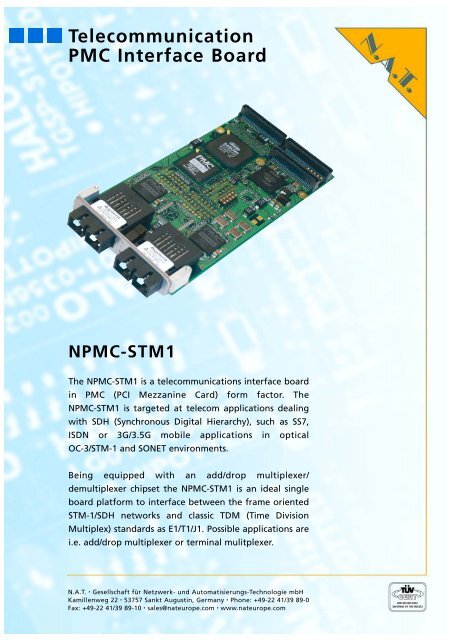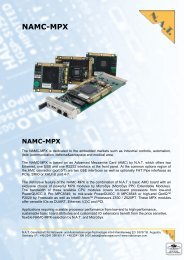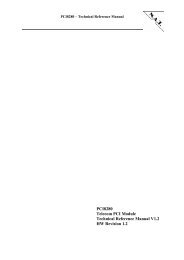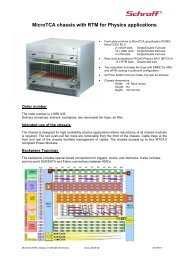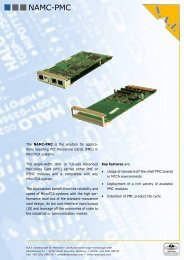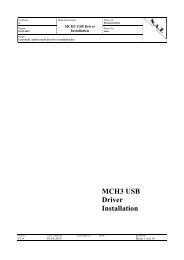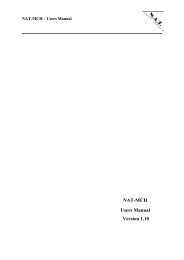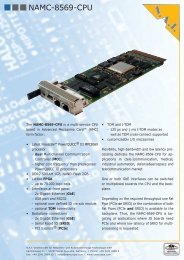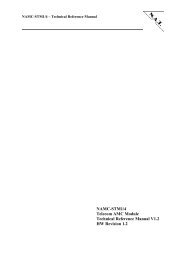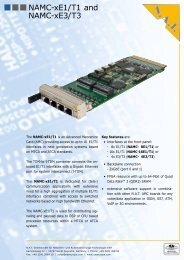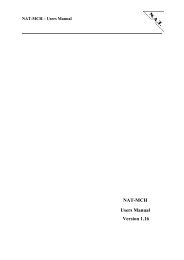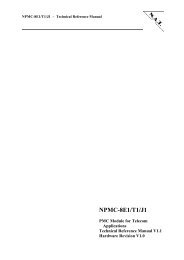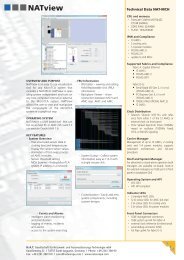Telecommunication PMC Interface Board NPMC-STM1 - NAT
Telecommunication PMC Interface Board NPMC-STM1 - NAT
Telecommunication PMC Interface Board NPMC-STM1 - NAT
Create successful ePaper yourself
Turn your PDF publications into a flip-book with our unique Google optimized e-Paper software.
<strong>Telecommunication</strong><br />
<strong>PMC</strong> <strong>Interface</strong> <strong>Board</strong><br />
N<strong>PMC</strong>-<strong>STM1</strong><br />
The N<strong>PMC</strong>-<strong>STM1</strong> is a telecommunications interface board<br />
in <strong>PMC</strong> (PCI Mezzanine Card) form factor. The<br />
N<strong>PMC</strong>-<strong>STM1</strong> is targeted at telecom applications dealing<br />
with SDH (Synchronous Digital Hierarchy), such as SS7,<br />
ISDN or 3G/3.5G mobile applications in optical<br />
OC-3/STM-1 and SONET environments.<br />
Being equipped with an add/drop multiplexer/<br />
demultiplexer chipset the N<strong>PMC</strong>-<strong>STM1</strong> is an ideal single<br />
board platform to interface between the frame oriented<br />
STM-1/SDH networks and classic TDM (Time Division<br />
Multiplex) standards as E1/T1/J1. Possible applications are<br />
i.e. add/drop multiplexer or terminal mulitplexer.<br />
N.A.T. � Gesellschaft für Netzwerk- und Automatisierungs-Technologie mbH<br />
Kamillenweg 22 � 53757 Sankt Augustin, Germany � Phone: +49-22 41/39 89-0<br />
Fax: +49-22 41/39 89-10 � sales@nateurope.com � www.nateurope.com
Technical Data<br />
Overview<br />
The N<strong>PMC</strong>-<strong>STM1</strong> is a telecommunications<br />
interface board in <strong>PMC</strong><br />
form-factor. Being equipped with an<br />
add/drop multiplexer/demultiplexer<br />
chipset and an H.110 controller the<br />
N<strong>PMC</strong>-<strong>STM1</strong> is targeted at telecom<br />
applications dealing with SDH, such as<br />
SS7, ISDN or 3G/3.5G mobile<br />
applications in optical OC-3/STM-1 and<br />
SONET environments.<br />
PCI-<strong>Interface</strong><br />
The N<strong>PMC</strong>-<strong>STM1</strong> is a P1386.1/<br />
Draft 2.0 compatible <strong>PMC</strong> module that<br />
can be plugged onto any VME, cPCI or<br />
other carrier board offering a <strong>PMC</strong><br />
extension slot. The PCI-to-local-bus<br />
bridge directly interconnects the<br />
PCI bus to the local bus and the<br />
onboard devices. The N<strong>PMC</strong>-<strong>STM1</strong> is<br />
PCI Rev. 2.2 compatible (32bit).<br />
Optical <strong>Interface</strong><br />
The two optical 155Mbps OC-3/STM-1<br />
line interfaces are available on two<br />
standard OC-3 SDH/STM-1 connectors<br />
at the front panel. The transceivers are<br />
available for single or multi-mode fibre<br />
access. Each of the transceivers is<br />
connected to a <strong>PMC</strong>-Sierra ARROW<br />
155 framer, both framers being<br />
connected to each other supporting<br />
the Automatic Protection Switching<br />
(APS).<br />
VT/TU Access<br />
The two ARROW155 framers are<br />
connected to the TEMUX84 of<br />
<strong>PMC</strong>-Sierra, an add/dropmultiplexer/<br />
demultiplexer chip. Since the chip does<br />
the complete SDH pointer processing it<br />
is capable of accessing STS-1 SPEs<br />
(Synchronous Payload Envelopes),<br />
TUG3 tributary unit groups within in<br />
VC4 container as well as in VC3 virtual<br />
containers and thus to extract/insert<br />
any of the 84 T1/J1 or 63 E1 streams<br />
including the respective clocking information<br />
contained in a single STM-1<br />
SDH frame. Supported mappings are<br />
VT1.5/VT-2 to STS-1 SPE, TU-11/TU-12<br />
to STM-1/VC3 or toTUG3 to<br />
STM-1/VC4. The chip supports the<br />
M13 and G.747 multiplexing.<br />
T1/J1/E1 Access<br />
The multiplexer/demultiplexer function<br />
block of the TEMUX84 interfaces to<br />
internal 84 T1/J1 framers or<br />
63 E1 timesliced framers, each having<br />
individual Rx/Tx, CLK and SYNC<br />
signals. For T1 the framing standards<br />
SF, SLC-96 and ESF, for E1 G.704 and<br />
G.706 (CRC-4 multiframe), for J1 the<br />
TTC JT-G.704 as well CRC-6 calculation<br />
are supported. The chip also provides<br />
full jitter attenuation.<br />
H.110 <strong>Interface</strong><br />
The T1/J1/E1 framers interface to the<br />
onboard H.110 contoller, the Zarlink<br />
MT90866. The H.110 controller allows<br />
flexible 64kbps timeslot routing<br />
between the various T1/J1/E1 streams<br />
as well as the selection of one of the<br />
T1/J1/E1 clocks as the master clock for<br />
the TDM backplane bus. Thus it is<br />
possible to distribute all 84 T1/J1 or 63<br />
E1 streams jitter-free and synchronised<br />
via the backplane.<br />
Backplane TDM Access<br />
The onboard H.110 bus controller<br />
offers access to the backplane TDM<br />
bus supporting full the H.110 bus<br />
(PTMC) or the SC Bus subset on the<br />
<strong>PMC</strong> multi-purpose I/O connectors.<br />
N.A.T.<br />
Gesellschaft für Netzwerk- und Automatisierungs-Technologie mbH<br />
Kamillenweg 22 � 53757 Sankt Augustin, Germany � Phone: +49-22 41/39 89-0<br />
Fax: +49-22 41/39 89-10 � sales@nateurope.com � www.nateurope.com<br />
PCI <strong>Interface</strong> and Compliance<br />
PCI Rev. 2.2, 33MHz/32bit<br />
H.110 Bus (and subsets thereof)<br />
H.110 (PTMC) and SCSA subset<br />
Networking<br />
Two OC3 SDH/<strong>STM1</strong> optical fibre on<br />
standard connector at front panel<br />
(SC duplex single or multi mode<br />
transceiver)<br />
Indicator LEDs<br />
4 software programmable LEDs at the<br />
front panel<br />
Operating System Support<br />
OK-1, VxWorks, LINUX<br />
Power Consumption<br />
3.3V 2.2A (max.), to be determined<br />
Environmental<br />
Temperature (operating): 0ºC to +60ºC<br />
with forced air cooling<br />
Temperature (storage): -40ºC to +85ºC<br />
Relative Humidity: 10% to 90%<br />
at +55ºC (non-condensing)<br />
Standard Compliance<br />
P1386 and P1386.1/Draft 2.0<br />
Applications<br />
- high density multiplexers, multi-service<br />
switches, edge routers and digital<br />
modems<br />
- Frame Relay switches and access<br />
devices-<br />
- SONET/SDH add drop and terminal<br />
multiplexers<br />
- optical access equipment<br />
- digital access cross-connect<br />
systems


